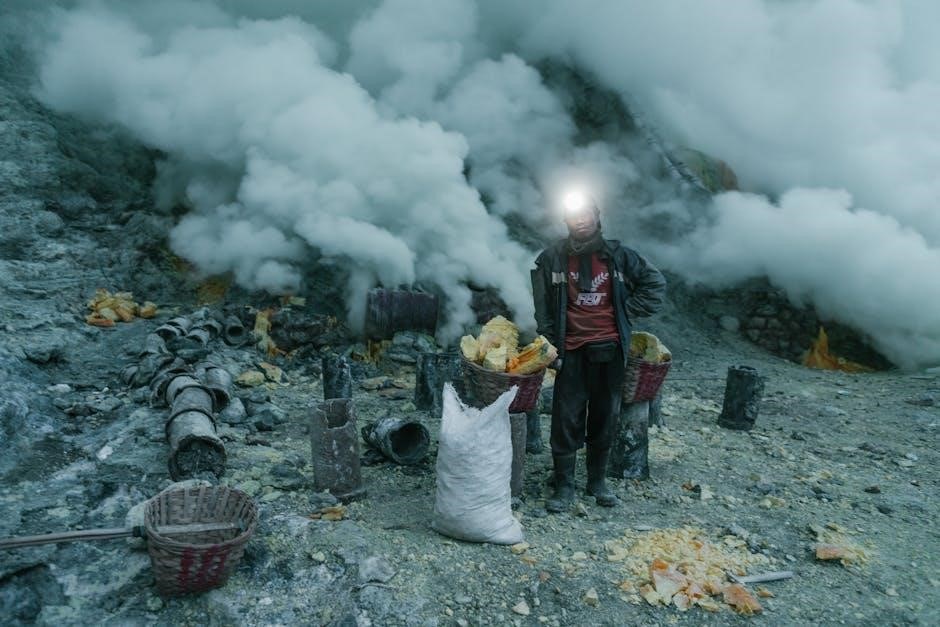Hard manual work involves substantial physical exertion, often repetitively, demanding strength and endurance. It typically requires minimal specialized training and focuses on tangible, physical tasks, differing from intellectual or creative labor.
Definition and Scope of Hard Manual Work
Hard manual work is defined by its reliance on physical strength and stamina to perform tasks. It encompasses occupations where physical exertion is the primary requirement, distinguishing it from jobs demanding intellectual or creative skills. The scope of hard manual work is broad, including various industries like construction, agriculture, landscaping, and manufacturing. These jobs often involve repetitive motions, heavy lifting, and prolonged periods of physical activity.
The defining characteristic is the direct application of physical force to manipulate objects or perform tasks, demanding considerable endurance. Workers in these fields often face challenging environmental conditions, such as extreme temperatures or outdoor settings, which further amplify the physical demands. While some manual labor positions may require specific skills, the core element remains the consistent and strenuous use of physical capabilities.

Hard Manual Work: An Overview
Examples of Hard Manual Labor Occupations
Numerous occupations exemplify hard manual labor across diverse sectors. Construction workers, for instance, engage in physically demanding tasks like lifting heavy materials, operating machinery, and building structures. Agricultural laborers perform strenuous activities such as planting, harvesting, and tending to crops, often under harsh weather conditions. Landscapers tackle tasks involving heavy lifting, digging, and operating equipment to maintain outdoor spaces.
Manufacturing roles frequently involve repetitive physical work on assembly lines, requiring prolonged standing and physical exertion. Mining is another prime example, demanding physical strength and endurance to extract resources from underground or open-pit mines. These occupations, while vital to various industries, consistently involve intense physical activity and highlight the demanding nature of hard manual labor. The work is often performed in challenging environments, further increasing the physical toll on workers.
Hard manual work demands significant physical exertion. It includes heavy lifting, repetitive motions, prolonged standing, and awkward postures, pushing the body’s limits and leading to fatigue and strain.
Common Physical Exertions and Challenges
Hard manual labor presents numerous physical challenges daily. Workers frequently lift heavy objects, sometimes exceeding safe limits, leading to back injuries and hernias. Repetitive motions, such as those in assembly lines or construction, cause carpal tunnel syndrome and tendonitis. Prolonged standing or walking, common in jobs like landscaping or factory work, results in foot, leg, and back pain. Working in awkward positions, like bending or twisting, further strains the musculoskeletal system.
Environmental factors, such as extreme temperatures or exposure to harmful substances, add to the physical burden. The combination of these factors significantly increases the risk of both acute injuries and chronic health problems, making hard manual labor exceptionally demanding on the body. Adequate safety measures and proper training are essential to mitigate these risks and protect the well-being of manual laborers.

The Physical Demands of Hard Manual Work
Potential for Injury and Long-Term Health Effects
The physically demanding nature of hard manual work carries a significant risk of injury and long-term health issues. Acute injuries, like sprains, strains, fractures, and cuts, are common due to accidents, heavy lifting, or repetitive motions. Chronic conditions, such as osteoarthritis, back pain, and carpal tunnel syndrome, often develop over time due to the wear and tear on the body. Exposure to hazardous materials can lead to respiratory problems, skin disorders, and even cancer.
Furthermore, the stress and physical exhaustion associated with manual labor can contribute to cardiovascular problems and mental health issues. The cumulative effect of these factors can significantly reduce a worker’s quality of life and ability to continue working in the long term. Preventative measures, including proper training, protective equipment, and ergonomic adjustments, are crucial for mitigating these risks and safeguarding the health of manual laborers.

The Economic Realities of Hard Manual Work
Wages for manual labor jobs often remain low despite the physical demands. Compensation varies based on skill, location, and industry, impacting financial stability and overall economic well-being of workers.
Wages and Compensation for Manual Labor

Manual laborers frequently face the challenge of earning modest wages relative to the physical demands and risks associated with their occupations. Industries often undervalue the essential contributions of individuals engaged in strenuous physical work, leading to lower hourly rates and limited benefits packages. The economic realities of manual labor can be stark, as workers may struggle to afford basic necessities and secure long-term financial stability, even with consistent employment. Geographic location and industry sector also play significant roles in determining compensation levels, with some regions and trades offering slightly better pay or union protections.
However, the overall trend indicates a persistent wage gap between manual labor and jobs requiring higher education or specialized skills, contributing to economic disparities and limiting opportunities for advancement for those who depend on physical labor for their livelihoods. This economic strain highlights the need for fair wages, improved benefits, and greater recognition of the value of manual labor in society.
Job Availability and Security in Manual Labor Industries
The availability of jobs in manual labor industries can fluctuate based on economic conditions and technological advancements. While certain sectors like construction and manufacturing may experience periods of high demand, automation and outsourcing can pose threats to long-term job security for manual laborers. Economic downturns often lead to layoffs and reduced hiring, impacting those in physically demanding roles disproportionately.
Furthermore, the physically taxing nature of manual labor can affect job longevity, as workers may face limitations due to injury or age-related decline. The lack of comprehensive safety measures and adequate healthcare access can exacerbate these challenges, creating instability in employment. Investing in training programs and promoting safer working conditions can enhance job security and improve the overall outlook for individuals engaged in manual labor.

The Social Perception of Hard Manual Work
Social perception of manual labor often undervalues the skill and effort involved. Despite its essential contributions, it frequently faces societal biases and limited recognition compared to white-collar professions.
Societal Value and Recognition of Manual Laborers

Societal value and recognition for manual laborers often lag behind other professions, despite their critical contributions to infrastructure, construction, and various essential services. This disparity stems from historical biases and a prevailing perception that undervalues physical labor compared to intellectual pursuits.
Manual laborers are the backbone of many industries, ensuring the smooth functioning of daily life through their hard work and dedication. However, this contribution is frequently overlooked, leading to a lack of appreciation and respect within the broader community. Recognizing the true value of manual labor requires a shift in societal attitudes, acknowledging the skills, resilience, and essential role these workers play in building and maintaining our world. Promoting fair wages, safe working conditions, and opportunities for advancement can significantly enhance the social standing of manual laborers, fostering a culture of respect and gratitude for their vital services. This recognition should extend beyond mere acknowledgment to encompass tangible benefits and support systems that reflect their importance to society.
Challenges in Hiring and Retaining Manual Laborers
Hiring and retaining manual laborers presents significant challenges due to several factors, including demanding physical requirements, relatively low wages, and limited opportunities for career advancement. Many individuals are hesitant to pursue careers involving hard manual work, opting instead for occupations perceived as less strenuous and offering better compensation.

Consequently, companies often struggle to find qualified and willing candidates, leading to labor shortages and project delays. The physically demanding nature of the work also contributes to high turnover rates, as laborers may experience burnout, injuries, or seek alternative employment with better working conditions. To mitigate these challenges, employers must prioritize fair wages, comprehensive benefits packages, and robust safety measures to attract and retain skilled manual laborers. Investing in training programs, providing opportunities for skill development, and fostering a supportive work environment can also enhance job satisfaction and reduce employee turnover, ensuring a stable and reliable workforce.
Words synonymous with hard manual work include “labor,” “donkeywork,” “elbow grease,” and “overwork.” These terms often emphasize the physical effort, exertion, and sometimes, the tedious nature of such tasks.
Words like Labour, donkeywork, elbow grease, overwork
The English language provides many vivid synonyms for “hard manual work,” each carrying subtle nuances. “Labour” is a direct and formal term, emphasizing effort and exertion. “Donkeywork” suggests tasks that are tedious, repetitive, and require little skill. “Elbow grease” is an informal idiom for energetic physical effort, often involving cleaning or polishing. “Overwork” implies excessive labor that strains one’s physical capacity.
These words paint a picture of the toil involved in manual labor, from the straightforward exertion to the monotonous grind. They capture the essence of physical tasks and the challenges faced by those engaged in such work. While some terms are more formal and others colloquial, they all effectively convey the demands and nature of hard manual labor. It is important to consider the connotation of each word when describing this type of work.

Synonyms for Hard Manual Work

Words like strenuous work, arduous manual labor, backbreaking work
Synonyms for hard manual work like “strenuous work,” “arduous manual labor,” and “backbreaking work” highlight the intense physical demands involved. “Strenuous work” emphasizes the need for significant energy and effort. “Arduous manual labor” suggests a task that is not only physically demanding but also prolonged and difficult to endure. “Backbreaking work,” a more evocative term, directly implies the potential for physical strain and injury, particularly to the back.
These phrases underscore the toll that such labor can take on the body. They paint a picture of tasks that push individuals to their physical limits, requiring resilience and strength. When describing the severity of manual labor, these synonyms effectively communicate the challenges and potential health risks associated with such work. The imagery they evoke is one of hardship and physical endurance.
